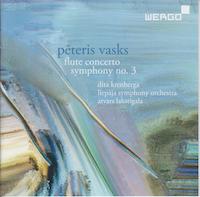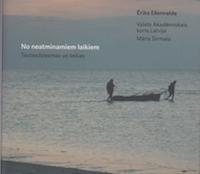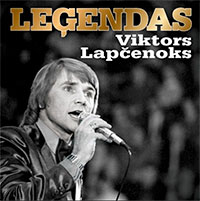2016 saw Latvian composer Pēteris Vasks’ 70th birthday. The German record label Wergo, a subsidiary of Schott Music (the publishers of Vasks’ music) took this opportunity to release a number of CDs of Vasks works, both symphonic and chamber music works. In collaboration with the Liepāja Symphony Orchestra and conductor Atvars Lakstīgala, one of the records released included two of Vasks’ major symphonic works – his Concerto for Flute and Orchestra and Symphony No. 3 for Large Orchestra.
Lakstīgala and the Liepāja Symphony Orchestra are no strangers to Vasks’ music, having actively performed and recorded his works, including his Symphony No. 2 on the Kurland Sounds disc, as well as his works ‘Sala’, ‘Musica Appassionata’, and ‘Credo’ also for a Wergo CD. Vasks himself is from the Kurzeme region of Latvia, and perhaps it is appropriate that an orchestra from this same region performs these works.
Vasks’ Flute Concerto is a demanding work, so it should be no surprise that one of Latvia’s premiere flutists – Dita Krenberga – plays the instrument on this recording. Much of Vasks’ music is ominous and full of foreboding, and the first movement ‘Cantabile 1’ of the work is a prime example. Krenberga’s flute and the orchestra begin quietly, as if unsure of which path to take, as they establish a melodic direction, which then gains in strength. Still, there is much trepidation in the flute, which, over the course of this movement, turns calmer, but still sorrowful.
The second movement ‘Quasi una burlesca’ is a jarring contrast to the first movement, with its sharp horn attacks and percussion at the beginning, signaling a dramatic return in tension, which also appears in the flute melody, which is now flittering and perhaps even fearful. Krenberga is given little respite in this movement, however, she maintains the necessary intensity and activity until the very end. The ‘burlesque’ of the title is presented through what is like a warped mirror, as it is at once frightful and containing dark humor. The middle section is where Krenberga shines, as it is an extended flute solo, and Krenberga’s performance is compelling and haunting, with its dramatic and melodic performance. The Concerto concludes with ‘Cantabile 2’, which is, like the first movement, more peaceful, but still maintains the overall tension of the work until the final notes.
Themes of nature, as well as Latvian identity often appear in Vasks’ works, and Symphony No. 3 is no exception. According to Vasks, while composing this monumental work (at nearly 40 minutes, it is one of his longest symphonic works), he pondered themes like ‘loss and the strength to move forward’ and ‘the endless battle between darkness and light’, and these weighty topics manifest themselves in many ways throughout the work. With six movements, the work takes the listener on an extensive and emotional journey, both somber and hopeful.
The pulsating first movement, with a kind of heartbeat provided by the percussion is then followed by the more anxious second movement, with its crashing snare drums and rising tension in the strings, compounded by further thundering percussion. The stormy fourth movement, with the horns and strings alternating alarming sounds, could be interpreted as a final warning to humanity. The sweeping sixth and final movement provides a small glimmer of hope, and also features one of Vasks’ trademarks – instruments replicating the sounds of birds, as if perhaps to suggest a new day may be dawning.
The Liepāja Symphony Orchestra, conducted by Atvars Lakstīgala, once again show not only their talent and skill, but also their innate understanding and appreciation for Vasks’ music. Dramatic and emotional, as well as mysterious and foreboding, the Orchestra reveals the many complex and dense layers of his works. Along with flutist Dita Krenberga, the musicians provide a definitive performance of Pēteris Vasks’ Concerto for Flute. And, in a towering performance, Lakstīgala inspires a monumental performance of the composer’s Symphony No. 3. This CD is yet another exceptional release of Vasks’ music from the Wergo label, provided by exceptional Latvian musicians.
For further information, please visit the Wergo website and the Liepāja Symphony Orchestra website.






